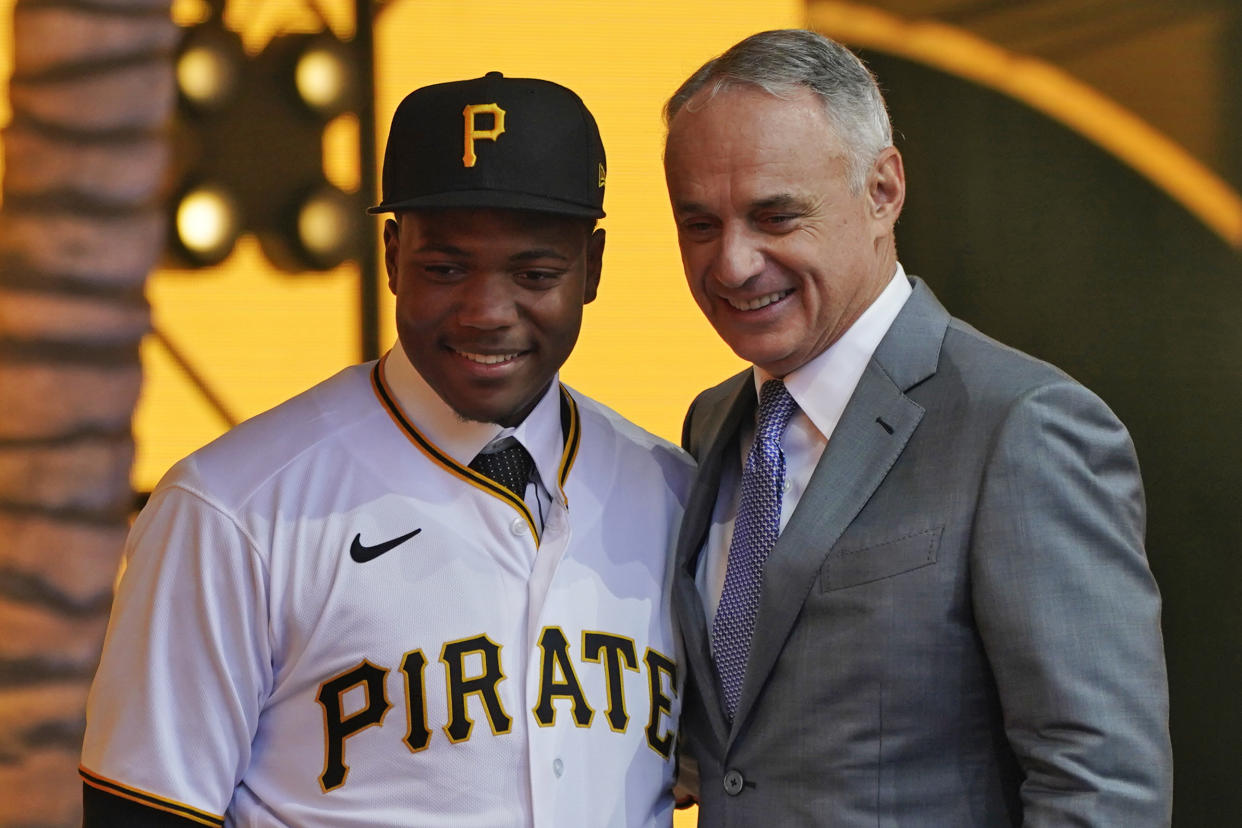Here's what the MLB draft needs for fans to care enough to actually watch
Once again, Major League Baseball has endeavored to make the Rule 4 draft a spectator-worthy affair. What was once a niche event, technically televised although with little fanfare, hosted in Secaucus, New Jersey, in June has become … well, still a niche event crammed somewhat awkwardly into its own day amid the unrelated All-Star festivities.
Starting last year, the draft has become an open-to-the-public amalgamation of pomp and circumstance, mascots and media, influencers and activations, all pointed at a stage upon which MLB commissioner Rob Manfred makes periodic appearances — to a chorus of boos from the fans who bothered to show up — to put a team on the clock. Then, after some dozens of seconds pass with only a countdown to look at, Manfred announces the name of some uber-talented teenager who might be — but probably is not — in attendance. And then the newest member of a major league baseball organization disappears into the minors, where even the highest-touted draftees will go largely unseen by anyone except prospect writers and the residents of towns like Tacoma and Toledo.
So you can see why the sport struggles to market the draft as a must-see event.

MLB’s draft is never going to rival that of football or basketball — the death-grip on the national sports subconscious of the former and cultural cache of the latter give them an inherent advantage even before the specific constructions of the drafts themselves come into play. Even hockey players can make a more immediate impact on the team that took them or else go play on an NCAA team with a built-in fan base. Baseball has to overcome the drudgery and esoteric structure if the draft is going to matter to anyone outside the game.
Or, hear me out, lean into the inside-baseball-ness. Rather than having old-timers on location to represent the teams, bring the executives actually making the decision to the event. Make the general managers, presidents of baseball operations and/or scouting directors do draft at the draft. Put them at a desk somewhere visible and let them bring a binder and one other front-office employee. I don’t think we can stop them from taking calls or texts from their staff off site, but when a team is on the clock, let’s see them sweat. And when a pick is made, let’s see them congratulate their selection in person.
Oh, they would hate it. As it stands, teams gather in well-staffed war rooms around the country to make the most informed possible last-minute decisions and real-time reactions, entirely unaffected by the televised product. Forcing them to participate in the spectacle would be an annoyance in exchange for making the spectacle more substantive. So allow me to justify this radical reimagining — from a powerless position, which can serve to only antagonize the people more directly involved.
Because of the minor leagues of it all, the MLB draft isn’t well poised to be an entry point for the casual sports fan just looking to get acquainted with baseball. At its best, the draft is an event for fans who are already invested in their favorite team’s farm system, or are looking to learn more about it. And those people care about the executives responsible for shaping the franchise's future. Because baseball is a sport for jocks and nerds! The very next day will highlight baseball’s brawniest mashing massive dingers in the Home Run Derby. On Sunday, we can put some plaid button-downs and polos on center stage.
It would make the media show up. That sounds self-serving, but the whole point is to drum up attention. As it stands, the league is trying to grow the on-site footprint of the draft, while it remains best covered from home or a hotel room since the only opportunity to talk to someone affiliated with the team will happen over Zoom. If the people who cover a team think there isn’t anything to see, why should fans?
More important, it might make the players themselves show up. The most engaging aspect of the draft is watching a young athlete’s life change in an instant. And the drafts that make for good TV capture that — along with the cool suits they’re sporting — over and over as each successive selection is announced. And, unlike in other leagues, currently only a handful of baseball players attend. Technology means they can do interviews from home shortly thereafter and often we do see them receive the news while surrounded by family and friends in blurry footage. But put the person responsible for making their dreams come true in the room, and I bet you get more guys to show up, stand on stage, put on their new hat and jersey in front of the other members of their class, cry about how much their high school catcher means to them, and make all the media appearances MLB can imagine.
Also, it would be weird. When the best part of the televised product is a flub from a former player, it’s time to shake things up, show us the actual action (which, again, is a bunch of baseball brainiacs frantically scanning scouting reports) and create more opportunities for unexpected moments.
And if you really want to get wacky? Schedule and air the forthcoming draft lottery just a few hours before the draft itself.
